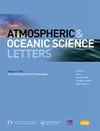改进的蜣螂优化器、多头注意力和混合深度学习算法在中国宁夏地区地下水深度预测中的应用
IF 3.2
4区 地球科学
Q3 METEOROLOGY & ATMOSPHERIC SCIENCES
引用次数: 0
摘要
由于缺乏准确的数据和复杂的参数化,地下水深度的预测对数值模型来说是一个挑战。机器学习可以有效地解决这一问题,并在许多地区的地下水深度预测中被证明是有用的。本文将两个新模型应用于宁夏地区地下水深度的预测。这两种模型将改进的蜣螂优化器(DBO)算法与多头注意卷积神经网络-长短期记忆网络(MH-CNN-LSTM)和多头注意卷积神经网络-门控循环单元(MH-CNN-GRU)两种深度学习模型相结合。DBO模型预测效果较好,相关系数R、残差预测偏差RPD较大,均方根误差RMSE较低。与原始DBO模型相比,改进DBO模型的R和RPD提高了1.5%以上,RMSE降低了1.8%以上,表明预测效果较好。此外,与传统的统计模型多元线性回归模型相比,深度学习模型具有更好的预测性能。这两个模型将改进的蜣螂优化(DBO)算法与两个深度学习模型相结合,即多头注意力——卷积神经网络——长短期记忆网络和多头注意力——回旋神经网络——门控递归单元。带有DBO的模型预测结果表现出更大的相关系数(R),残差预测偏差(RPD)和较低的均方根误差(RMSE),预测结果更好。此外,与DBO模型相比,改进后的DBO模型的R和RPD增加了1.5%以上,RMSE降低了1.8%以上,表明预测结果更好。与传统的统计模型多元线性回归模型相比, 深度学习模型具有更好的预测性能.本文章由计算机程序翻译,如有差异,请以英文原文为准。

Application of the improved dung beetle optimizer, muti-head attention and hybrid deep learning algorithms to groundwater depth prediction in the Ningxia area, China
Due to the lack of accurate data and complex parameterization, the prediction of groundwater depth is a challenge for numerical models. Machine learning can effectively solve this issue and has been proven useful in the prediction of groundwater depth in many areas. In this study, two new models are applied to the prediction of groundwater depth in the Ningxia area, China. The two models combine the improved dung beetle optimizer (DBO) algorithm with two deep learning models: The Multi-head Attention–Convolution Neural Network–Long Short Term Memory networks (MH-CNN-LSTM) and the Multi-head Attention–Convolution Neural Network–Gated Recurrent Unit (MH-CNN-GRU). The models with DBO show better prediction performance, with larger R (correlation coefficient), RPD (residual prediction deviation), and lower RMSE (root-mean-square error). Compared with the models with the original DBO, the R and RPD of models with the improved DBO increase by over 1.5%, and the RMSE decreases by over 1.8%, indicating better prediction results. In addition, compared with the multiple linear regression model, a traditional statistical model, deep learning models have better prediction performance.
摘要
本研究将两个新模型应用于位于中国西北干旱半干旱区的宁夏地区地下水深度预测. 这两个模型将改进的蜣螂优化 (DBO) 算法与两个深度学习模型相结合, 即多头注意力-卷积神经网络-长短期记忆网络和多头注意力-回旋神经网络-门控递归单元. 带有DBO的模型预测结果表现出更大的相关系数 (R) , 残差预测偏差 (RPD) 和较低的均方根误差 (RMSE) , 预测结果更好. 此外, 与DBO模型相比, 改进后的DBO模型的R和RPD增加了1.5%以上, RMSE降低了1.8%以上, 表明预测结果更好. 与传统的统计模型多元线性回归模型相比, 深度学习模型具有更好的预测性能.
求助全文
通过发布文献求助,成功后即可免费获取论文全文。
去求助
来源期刊

Atmospheric and Oceanic Science Letters
METEOROLOGY & ATMOSPHERIC SCIENCES-
CiteScore
4.20
自引率
8.70%
发文量
925
审稿时长
12 weeks
 求助内容:
求助内容: 应助结果提醒方式:
应助结果提醒方式:


